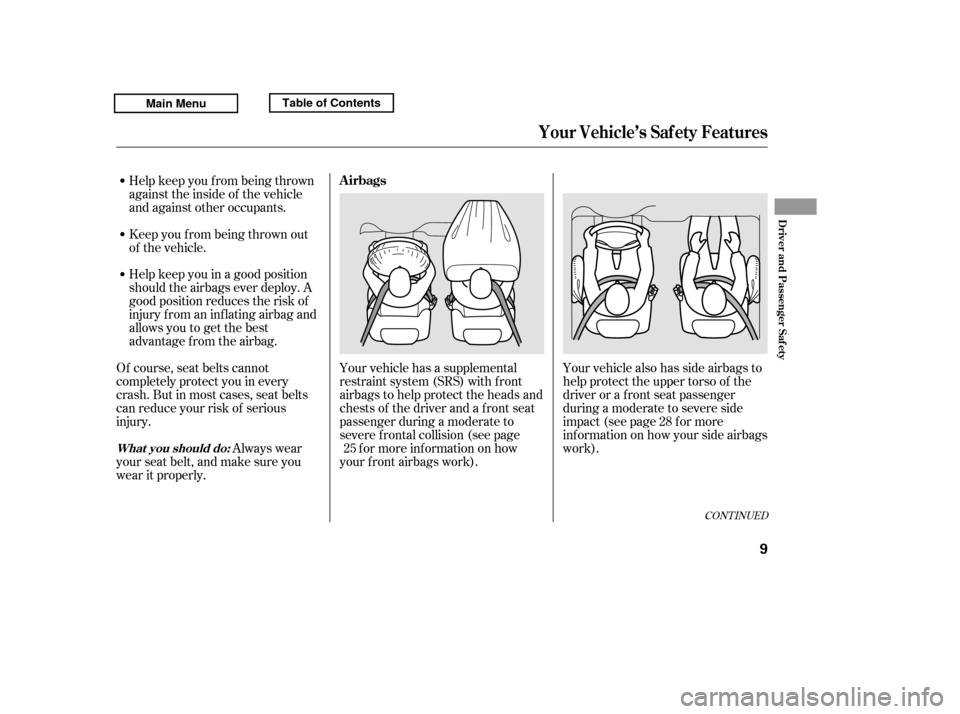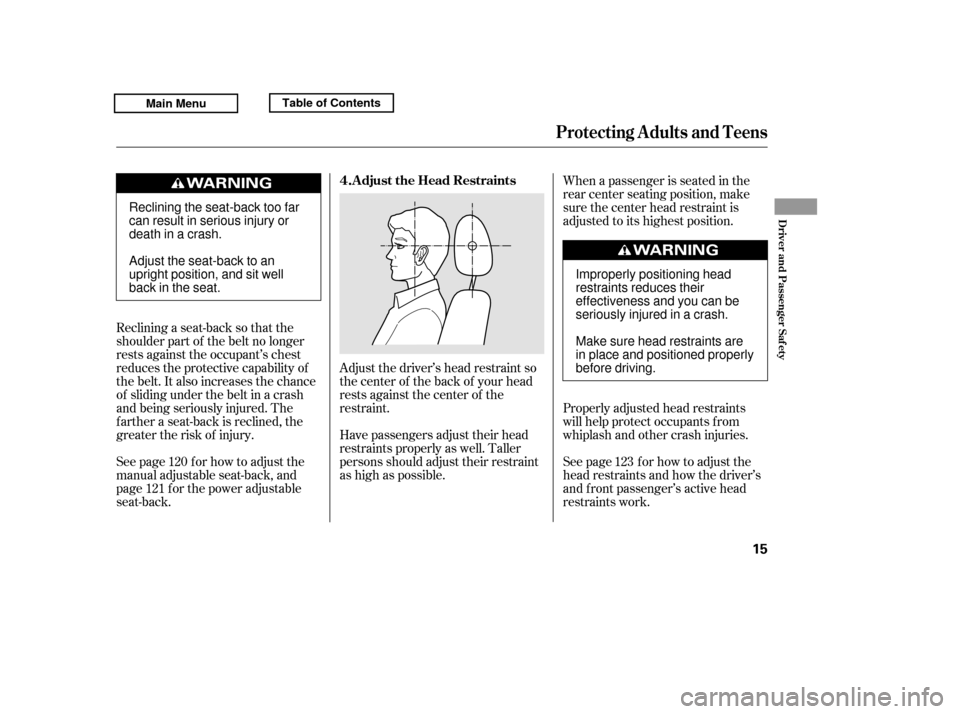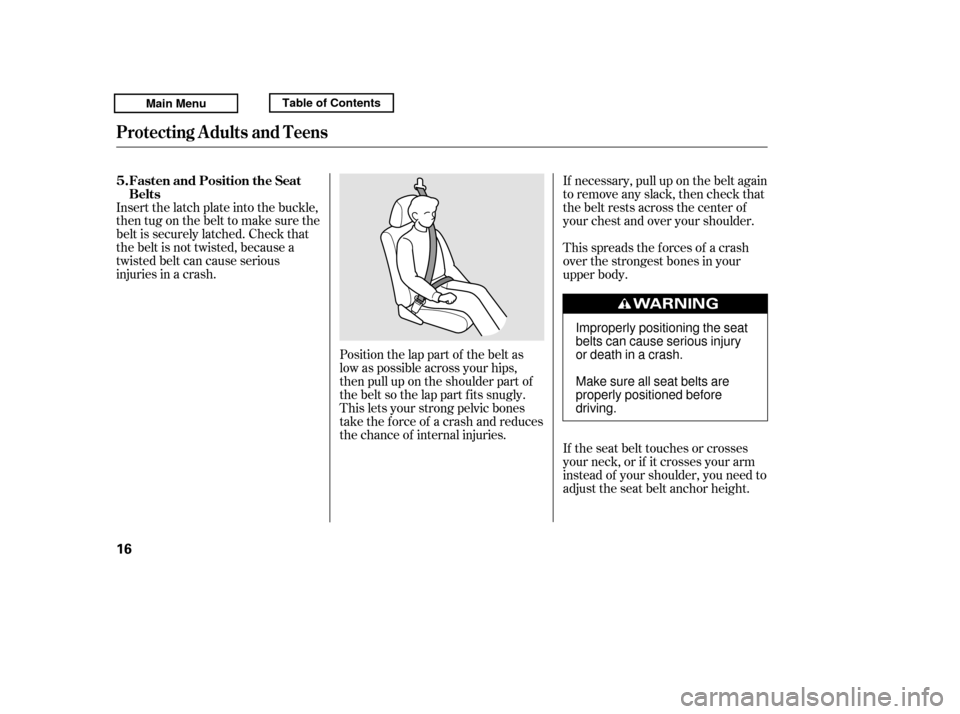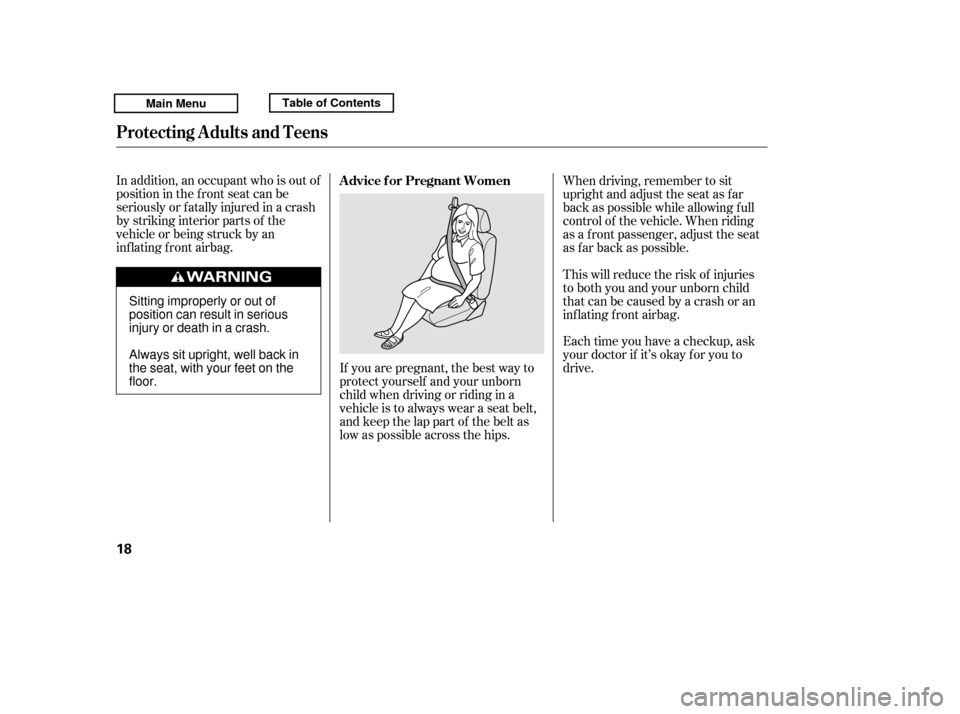2011 HONDA RIDGELINE belt
[x] Cancel search: beltPage 13 of 427

Your vehicle has a supplemental
restraint system (SRS) with f ront
airbags to help protect the heads and
chests of the driver and a front seat
passenger during a moderate to
severe f rontal collision (see pagef or more inf ormation on how
your f ront airbags work). Your vehicle also has side airbags to
help protect the upper torso of the
driver or a f ront seat passenger
during a moderate to severe side
impact (see page f or more
information on how your side airbags
work).
Help keep you in a good position
should the airbags ever deploy. A
good position reduces the risk of
injury f rom an inf lating airbag and
allows you to get the best
advantage f rom the airbag.
Of course, seat belts cannot
completely protect you in every
crash.Butinmostcases,seatbelts
can reduce your risk of serious
injury. Always wear
your seat belt, and make sure you
wear it properly. Help keep you f rom being thrown
against the inside of the vehicle
and against other occupants.
Keep you f rom being thrown out
of the vehicle.
25 28
CONT INUED
Your Vehicle’s Saf ety Features
Airbags
What you should do:
Driver and Passenger Saf ety
9
Main MenuTable of Contents
Page 14 of 427

The rest of this section gives more
detailed inf ormation about how you
can maximize your saf ety.
The most important things you need
to know about your airbags are:
They are designed to supplement
the seat belts.
Remember, however, that no saf ety
system can prevent all injuries or
deaths that can occur in a severe
crash, even when seat belts are
properly worn and the airbags deploy.Always wear
your seat belt properly, and sit
upright and as f ar back f rom the
steering wheel as possible while
allowing f ull control of the vehicle. A
f ront passenger should move their
seat as far back from the dashboard
as possible.
To do their job, airbags must
inf late with tremendous f orce. So
while airbags help save lives, they
can cause minor injuries or more
serious or even fatal injuries if
occupants are not properly
restrained or sitting properly.
In addition, your vehicle has side
curtain airbags to help protect the
heads of the driver, f ront passenger,
and passengers in the outer rear
seating positions during a moderate
to severe side impact or rollover (see
page f or more inf ormation on how
your side curtain airbags work).
30
Your Vehicle’s Saf ety Features
Airbags do not replace seat belts. What you should do:
Airbags can pose serious hazards.
A irbags of f er no prot ect ion in rear
collisions, or minor f ront al or side collisions.
10
Main MenuTable of Contents
Page 19 of 427

Adjust the driver’s head restraint so
the center of the back of your head
rests against the center of the
restraint.
Reclining a seat-back so that the
shoulder part of the belt no longer
rests against the occupant’s chest
reduces the protective capability of
the belt. It also increases the chance
of sliding under the belt in a crash
and being seriously injured. The
farther a seat-back is reclined, the
greater the risk of injury. When a passenger is seated in the
rear center seating position, make
sure the center head restraint is
adjusted to its highest position.
Properly adjusted head restraints
will help protect occupants f rom
whiplash and other crash injuries.
Have passengers adjust their head
restraints properly as well. Taller
persons should adjust their restraint
as high as possible.
See page f or how to adjust the
manual adjustable seat-back, and
page f or the power adjustable
seat-back. See page f or how to adjust the
head restraints and how the driver’s
and f ront passenger’s active head
restraints work.
120
121 123
Protecting A dults and T eens
A djust the Head Restraints
4.
Driver and Passenger Saf ety
15
Reclining the seat-back too far
can result in serious injury or
death in a crash.
Adjust the seat-back to an
upright position, and sit well
back in the seat. Improperly positioning head
restraints reduces their
effectiveness and you can be
seriously injured in a crash.
Make sure head restraints are
in place and positioned properly
before driving.
Main MenuTable of Contents
Page 20 of 427

Position the lap part of the belt as
low as possible across your hips,
then pull up on the shoulder part of
the belt so the lap part f its snugly.
This lets your strong pelvic bones
take the force of a crash and reduces
the chance of internal injuries.
Insert the latch plate into the buckle,
then tug on the belt to make sure the
belt is securely latched. Check that
the belt is not twisted, because a
twisted belt can cause serious
injuries in a crash.
If necessary, pull up on the belt again
to remove any slack, then check that
the belt rests across the center of
your chest and over your shoulder.
This spreads the f orces of a crash
over the strongest bones in your
upper body.
If the seat belt touches or crosses
your neck, or if it crosses your arm
instead of your shoulder, you need to
adjust the seat belt anchor height.
Fasten and Position the Seat
Belts
5.
Protecting A dults and T eens
16
Improperly positioning the seat
belts can cause serious injury
or death in a crash.
Make sure all seat belts are
properly positioned beforedriving.
Main MenuTable of Contents
Page 21 of 427

CONT INUED
This could cause
very serious injuries in a crash.
See page f or additional
inf ormation about your seat belts
and how to take care of them.
The front seats have adjustable seat
belt anchors. To adjust the height of
an anchor, squeeze the two release
buttons, and slide the anchor up or
down as needed (it has f our
positions). If a seat belt does not seem to work
as it should, it may not protect the
occupant in a crash.
After all occupants have adjusted
their seats and head restraints, and
put on their seat belts, it is very
important that they continue to sit
upright, well back in their seats, with
their feet on the floor, until the
vehicle is safely parked and the
engine is of f .
Using a seat
belt that is not working properly can
result in serious injury or death.
Have your dealer check the belt as
soon as possible. Sitting improperly can increase the
chance of injury during a crash. For
example, if an occupant slouches,
lies down, turns sideways, sits
forward, leans forward or sideways,
or puts one or both f eet up, the
chance of injury during a crash is
greatly increased.
20
Protecting A dults and T eens
Never place t he shoulder port ion of a
lap/shoulder belt under your arm orbehind your back.
No one should sit in a seat wit h aninoperat ive seat belt .Maintain a Proper Sitting
Position
6.
Driver and Passenger Saf ety
17
RELEASE
BUTTONS
Main MenuTable of Contents
Page 22 of 427

In addition, an occupant who is out of
position in the f ront seat can be
seriously or f atally injured in a crash
by striking interior parts of the
vehicle or being struck by an
inflating front airbag.If you are pregnant, the best way to
protect yourself and your unborn
child when driving or riding in a
vehicle is to always wear a seat belt,
and keep the lap part of the belt as
low as possible across the hips.When driving, remember to sit
upright and adjust the seat as f ar
back as possible while allowing f ull
control of the vehicle. When riding
as a f ront passenger, adjust the seat
as far back as possible.
This will reduce the risk of injuries
to both you and your unborn child
that can be caused by a crash or an
inflating front airbag.
Each time you have a checkup, ask
your doctor if it’s okay f or you to
drive.
Advice f or Pregnant Women
Protecting A dults and T eens
18
Sitting improperly or out of
position can result in serious
injury or death in a crash.
Always sit upright, well back in
the seat, with your feet on thefloor.
Main MenuTable of Contents
Page 23 of 427

If they do, they could be very
seriously injured in a crash.
If they do, they could
be killed or very seriously injured
in a crash.
They could be
killed or injured in a crash, or
become ill or even die f rom carbon
monoxide poisoning if engine
exhaust enters the cap.
A passenger who is not
wearing a seat belt during a crash
or emergency stop can be thrown
against the inside of the vehicle,
against other occupants, or out of
the vehicle. If they do, they
could be very seriously injured in a
crash.
Devices intended to improve
occupant comf ort or reposition the
shoulder part of a seat belt can
reduce the protective capability of
the seat belt and increase the
chance of serious injury in a crash.
Carrying hard or sharp
objects on your lap, or driving with
a pipe or other sharp object in
your mouth, can result in injuries
if your f ront airbag inf lates.
If your
hands or arms are close to an
airbag cover, they could be injured
if the airbag inf lates. Objects on
the covers marked ‘‘SRS AIRBAG’’
could interf ere with the proper
operation of the airbags or be
propelled inside the vehicle and
hurt someone if the airbags inf late.
If a side airbag or a
side curtain airbag inf lates, a cup
holder or other hard object
attached on or near the door could
be propelled inside the vehicle and
hurt someone.
Improperly replacing
or covering f ront seat-back covers
can prevent your side airbags f rom
inf lating during a side impact.
Protecting A dults and T eens
Additional Saf ety Precautions
Never let passengers ride in t he
area in front of a folded-up rearseat .
Never let passengers ride in t hepickup bed.
Never let passengers ride inside at ruck cap (shell).
Passengers should not st and up orchange seats while the vehicle is moving. T wo people should never use t he
same seat belt .
Do not put any accessories on seatbelts.
Do not place hard or sharp object sbet ween yourself and a f ront airbag.
K eep your hands and arms awayf rom t he airbag covers. Do not at t ach or place object s on
the f ront airbag covers.
Do not at t ach hard object s on ornear a door.
Do not cover or replace f ront seat -back covers wit hout consult ingyour dealer.
Driver and Passenger Saf ety
19
Main MenuTable of Contents
Page 24 of 427

Your seat belt system includes lap/
shoulder belts in all seating positions.
The f ront seat belts are also
equipped with automatic seat belt
tensioners.
This system uses the same sensors
as the front airbags to monitor
whether the f ront seat belts are
latched or unlatched, and how much
weight is on the f ront passenger’s
seat (see pages and ).If the indicator comes on or the
beeper sounds when the driver’s seat
belt is latched and there is no f ront
seat passenger and no items on the
front seat, something may be
interf ering with the monitoring
system. Look f or and remove:
Any items under the f ront
passenger’s seat.
Any object(s) hanging on the seat
or in the seat-back pocket.
Any object on the f loor that is
touching the rear of the seat-back.
If no obstructions are f ound, have
your vehicle checked by a dealer.
The seat belt system
includes an indicator on the
instrument panel and a beeper to
remind you and your passengers to
f asten your seat belts.
This system monitors the f ront seat
belts. If you turn the ignition switch
to the ON (II) position bef ore your
seat belt is f astened, the beeper will
sound and the indicator will f lash. If
your seat belt is not f astened bef ore the beeper stops, the indicator will
stop f lashing but remain on.
If a f ront passenger does not f asten
their seat belt, the indicator will
come on about 6 seconds af ter the
ignition switch is turned to the ON
(II) position.
If either the driver or a f ront
passenger does not f asten their seat
belt while driving, the beeper will
sound and the indicator will f lash
again at regular intervals.
You will also see a ‘‘FASTEN SEAT
BELT’’ or ‘‘FASTEN PASSENGER
SEAT BELT’’ message on the multi-
inf ormation display (see page ).
When no one is sitting in the f ront
passenger’s seat, or a child or small
adult is riding there, the indicator
should not come on and the beeper
should not sound.
27 28
90
On models with navigation system
Additional Inf ormation About Your Seat Belts
Seat Belt System Components
20
Main MenuTable of Contents